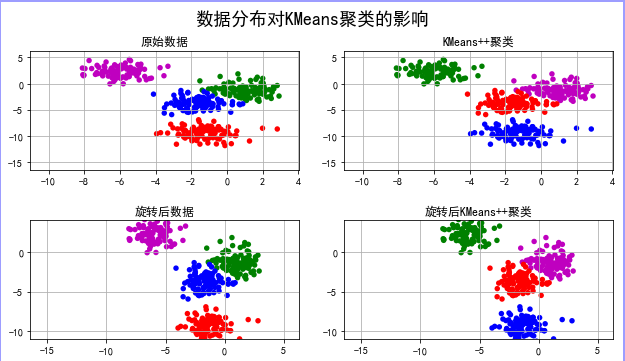1 # -*- coding: utf-8 -*- 2 """ 3 Created on Mon Sep 17 16:41:46 2018 4 5 @author: zhen 6 """ 7 8 import numpy as np 9 import matplotlib.pyplot as plt 10 import sklearn.datasets as ds 11 import matplotlib.colors 12 from sklearn.cluster import KMeans 13 from sklearn.cluster import MiniBatchKMeans 14 15 def expand(a, b): 16 d = (b - a) * 0.1 17 return a-b, b+d 18 19 if __name__ == "__main__": 20 N = 400 21 centers = 4 22 data, y = ds.make_blobs(N, n_features=2, centers=centers, random_state=2) 23 data2, y2 = ds.make_blobs(N, n_features=2, centers=centers, cluster_std=(1, 2.5, 0.5, 2), random_state=2) 24 # 按行拼接numpy数组 25 data3 = np.vstack((data[y == 0][:], data[y == 1][:50], data[y == 2][:20], data[y == 3][:5])) 26 y3 = np.array([0] * 100 + [1] * 50 + [2] * 20 + [3] * 5) 27 cls = KMeans(n_clusters=4, init='k-means++') 28 y_hat = cls.fit_predict(data) 29 y2_hat = cls.fit_predict(data2) 30 y3_hat = cls.fit_predict(data3) 31 32 m = np.array(((1, 1),(1, 3))) 33 data_r = data.dot(m) 34 y_r_hat = cls.fit_predict(data_r) 35 36 matplotlib.rcParams['font.sans-serif'] = [u'SimHei'] 37 matplotlib.rcParams['axes.unicode_minus'] = False 38 cm = matplotlib.colors.ListedColormap(list('rgbm')) 39 plt.figure(figsize=(9, 10), facecolor='w') 40 plt.subplot(421) 41 plt.title(u'原始数据') 42 plt.scatter(data[:, 0], data[:, 1], c=y, s=30, cmap=cm, edgecolors='none') 43 x1_min, x2_min = np.min(data, axis=0) 44 x1_max, x2_max = np.max(data, axis=0) 45 x1_min, x1_max = expand(x1_min, x1_max) 46 x2_min, x2_max = expand(x2_min, x2_max) 47 plt.xlim((x1_min, x1_max)) 48 plt.ylim((x2_min, x2_max)) 49 plt.grid(True) 50 51 plt.subplot(422) 52 plt.title(u'KMeans++聚类') 53 plt.scatter(data[:, 0], data[:, 1], c=y_hat, s=30, cmap=cm, edgecolors='none') 54 plt.xlim((x1_min, x1_max)) 55 plt.ylim((x2_min, x2_max)) 56 plt.grid(True) 57 58 plt.subplot(423) 59 plt.title(u'旋转后数据') 60 plt.scatter(data[:, 0], data[:, 1], c=y, s=30, cmap=cm, edgecolors='none') 61 #x1_min, x2_min = np.min(data_r, axis=0) 62 #x1_max, x2_max = np.max(data_r, axis=0) 63 #x1_min, x1_max = expand(x1_min, x1_max) 64 #x2_min, x2_max = expand(x2_min, x2_max) 65 plt.ylim((x1_min, x1_max)) 66 plt.xlim((x2_min, x2_max)) 67 plt.grid(True) 68 69 plt.subplot(424) 70 plt.title(u'旋转后KMeans++聚类') 71 plt.scatter(data[:, 0], data[:, 1], c=y_hat, s=30, cmap=cm, edgecolors='none') 72 plt.ylim((x1_min, x1_max)) 73 plt.xlim((x2_min, x2_max)) 74 plt.grid(True) 75 76 plt.subplot(425) 77 plt.title(u'方差不相等数据') 78 plt.scatter(data2[:, 0], data2[:, 1], c=y2, s=30, cmap=cm, edgecolors='none') 79 #x1_min, x2_min = np.min(data2, axis=0) 80 #x1_max, x2_max = np.max(data2, axis=0) 81 #x1_min, x1_max = expand(x1_min, x1_max) 82 #x2_min, x2_max = expand(x2_min, x2_max) 83 plt.xlim((x1_min, x1_max)) 84 plt.ylim((x2_min, x2_max)) 85 plt.grid(True) 86 87 plt.subplot(426) 88 plt.title(u'方差不相等KMeans++聚类') 89 plt.scatter(data2[:, 0], data2[:, 1], c=y2_hat, s=30, cmap=cm, edgecolors='none') 90 plt.xlim((x1_min, x1_max)) 91 plt.ylim((x2_min, x2_max)) 92 plt.grid(True) 93 94 plt.subplot(427) 95 plt.title(u'数量不相等数据') 96 plt.scatter(data3[:, 0], data3[:, 1], c=y3, s=30, cmap=cm, edgecolors='none') 97 #x1_min, x2_min = np.min(data3, axis=0) 98 #x1_max, x2_max = np.max(data3, axis=0) 99 #x1_min, x1_max = expand(x1_min, x1_max) 100 #x2_min, x2_max = expand(x2_min, x2_max) 101 plt.xlim((x1_min, x1_max)) 102 plt.ylim((x2_min, x2_max)) 103 plt.grid(True) 104 105 plt.subplot(428) 106 plt.title(u'数量不相等KMeans++聚类') 107 plt.scatter(data3[:, 0], data3[:, 1], c=y3_hat, s=30, cmap=cm, edgecolors='none') 108 plt.xlim((x1_min, x1_max)) 109 plt.ylim((x2_min, x2_max)) 110 plt.grid(True) 111 112 plt.tight_layout(2, rect=(0, 0, 1, 0.97)) 113 plt.suptitle(u'数据分布对KMeans聚类的影响', fontsize=18) 114 plt.show() 115
结果:


总结:可知不同的超参数对聚类的效果影响很大,因此在聚类之前采样的数据要尽量保持均匀,各类的方差最好先进行预研,以便达到较好的聚类效果!